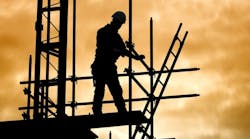ASSP To Enhance Standards to Guide Safety at Construction Sites
ASSP announced on August 10 that the ANSI/ASSP Z359 Fall Protection and Fall Restraint Committee will use the key findings from the Fall Experience Survey – which explored the root causes of falls from height – to enhance voluntary national consensus standards that guide safety at construction sites and many other workplaces.
“While data has been available on the types and rates of fatal and non-fatal falls, we need more information on the causes of those falls,” said Thomas Kramer, P.E., CSP, chair of the Z359 committee., in a statement “These new insights expand our knowledge so we can strengthen standards and ultimately prevent injuries and save lives.”
Falls are the leading cause of death among construction workers, notes ASSP and despite the efforts of safety and health professionals to increase the use of fall protection, 368 construction workers and 805 workers across all industries died from falls in 2020, according to the U.S. Bureau of Labor Statistics. Fall protection in construction has remained the most frequently cited OSHA violation each year since 2011.
Six key findings surfaced from the 671 responses to the Fall Experience Survey:
- Respondents believe that lack of adequate planning is a key underlying cause of falls. Insufficient or ineffective planning was the most selected primary cause for falls (27.4%).
- Lack of planning is associated with a lower likelihood of using fall protection. The odds of using fall protection were 71% lower for individuals whose employer or competent person did not do any planning compared to those whose employer or competent person did do planning or they were not sure.
- Nearly half (48.8%) of respondents said that no fall protection was being used at the time of the fall.
- Employee beliefs about their company’s fall protection policy are strongly associated with the use of fall protection. Respondents who believed fall protection was required by their employer were 8 times more likely to use fall protection compared to those who did not believe fall protection was required.
- Rescue training may help reduce fall-related deaths. The odds of a fall being fatal were 76% lower for those who had self-rescue training compared to those who did not have this training.
- Workers employed by subcontractors face an elevated risk of dying from falls. Individuals who worked for a subcontractor at the time of the fall incident were 2.7 times more likely to die from the fall compared to those who worked for a general contractor.
The 20-page preliminary report published this month by CPWR provides an overview of the main survey findings, and additional reports with further analyses are planned.
“It’s important to remember that all falls are preventable, and that drives us to collect better information that can foster operational solutions,” said Jessica Bunting, MPH, director of CPWR’s Research to Practice (r2p). “Our new data is directly from people who are knowledgeable about workplace environments where falls are common.”
About the Author
EHS Today Staff
EHS Today's editorial staff includes:
Dave Blanchard, Editor-in-Chief: During his career Dave has led the editorial management of many of Endeavor Business Media's best-known brands, including IndustryWeek, EHS Today, Material Handling & Logistics, Logistics Today, Supply Chain Technology News, and Business Finance. In addition, he serves as senior content director of the annual Safety Leadership Conference. With over 30 years of B2B media experience, Dave literally wrote the book on supply chain management, Supply Chain Management Best Practices (John Wiley & Sons, 2021), which has been translated into several languages and is currently in its third edition. He is a frequent speaker and moderator at major trade shows and conferences, and has won numerous awards for writing and editing. He is a voting member of the jury of the Logistics Hall of Fame, and is a graduate of Northern Illinois University.
Adrienne Selko, Senior Editor: In addition to her roles with EHS Today and the Safety Leadership Conference, Adrienne is also a senior editor at IndustryWeek and has written about many topics, with her current focus on workforce development strategies. She is also a senior editor at Material Handling & Logistics. Previously she was in corporate communications at a medical manufacturing company as well as a large regional bank. She is the author of Do I Have to Wear Garlic Around My Neck?, which made the Cleveland Plain Dealer's best sellers list.
Nicole Stempak, Managing Editor: Nicole Stempak is managing editor of EHS Today and conference content manager of the Safety Leadership Conference.
